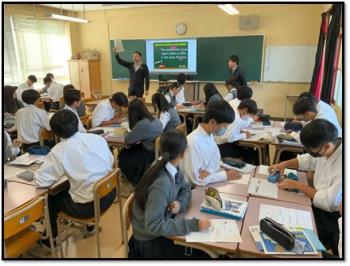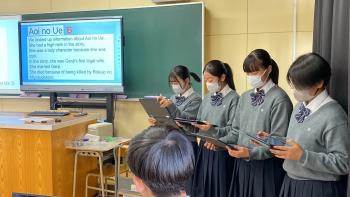|
Another Immersion
Class!
This year we
have been really busy with Immersion classes. In September, we had an immersion
lesson in health class. This time, the topic was “work-life balance”. For
homework, students recorded information about their daily schedules. They broke
up their time into three categories: Work, Relax, and Sleep. After they recorded
their information, students made a graph to visualize their personal work-life
balance as high school students.
今年度はイマージョン授業が盛りだくさんです。9月には「保健」のイマージョン授業を行いました。今回のトピックは「ワーク・ライフ・バランス」です。生徒たちは宿題として、事前に日々のスケジュールを「仕事(Work)」「自由時間(Relax)」「睡眠(Sleep)」の3つに分けて記録してきました。その後、生徒たちは高校生としてのワーク・ライフバランスを可視化するためのグラフを作成しました。

During the first class,
we discussed the good points and bad points of Japanese work culture. We then
watched a video on youtube where many Japanese were interviewed about the
societal problem of overworking.
1回目の授業では、日本の労働文化について良いところ・悪いところを議論しました。その後Youtubeで日本人が、社会問題となっている「過重労働」についてインタビューを受けている動画を見ました。
For
the second class, we looked up working cultures around the world and made
presentations highlighting the work-life balance techniques used in an attempt
to find potential solutions to Japan’s social problem of unbalanced work-life
balance.
2回目の授業では世界中の労働文化を調べました。その後、日本の不均衡なワークライフバランスという社会問題に対する解決策を見つけることができるよう、世界の取り組みに焦点を当ててプレゼンテーションを行いました。
Physics Class!

First
year students had a physics class in October. Our topic was “Newton’s Laws of
Motion”. For the lesson, students were divided up into groups and asked to
create a car propelled by a balloon. Each team, using their balloon car, tried
to knock over as many paper pet bottles as possible.
After
the experiment, using fun videos and props, students were introduced to
Newton’s Laws of Motion. After a small quiz to test their understanding,
students thought about which of the three laws of motion could be seen in the
balloon car experiment. A lot of students were surprised by the answer!
1年生では10月に「物理」のイマージョン授業を行いました。今回のトピックは「ニュートンの運動の3法則」です。授業では、生徒はグループに分かれてバルーンカーを作り、紙でできた筒をできるだけ多く倒すという実験に挑戦しました。
実験後、小道具や短い動画を利用しながら「ニュートンの運動の3法則」を学び、クイズを通して理解を深め、ニュートンの運動の3法則の動きについて考えました。たくさんの生徒が実験の意外な結果に驚いていたようです。
Genji and
Feminism?!

Second year
students got to study about “The Tale of Genji” and autonomy of women. Students
started the class by reviewing the background information of the story by
playing kahoot quiz game. After, students in groups research one female
character in the story and made a research presentation about her. They
researched her rank, relationship to Genji, and her personality. They also drew
a picture of their characters.
2年生では「源氏物語」を通して女性の(社会的)地位について学びました。まず、生徒はKahoot!を使って背景知識やストーリーを学びました。その後グループに分かれ、物語中の女性キャラクターについて地位や源氏との関係性、人間性などを調べてプレゼンテーションを行いました。
After making
their presentations, students presented their findings to the class. Using
google forms, students scored each speech and finally the winning team got a
prize. After the students learned about the various women in the story, they
played another kahoot game to discuss the autonomy of women in the story and
brain-storm ways that they could relate to the characters.
その後、その中から発見をクラスで共有し、google formを使ってそれぞれのスピーチに点数をつけお互いに評価しました。最も評価の高かったグループにはなんとカイル先生からのプレゼント。その後源氏物語の中の女性の社会的立場について議論したり、登場人物と自分自身を関連付けて考えたりしました。
Using our own
experiences, students found new ways to empathize with the characters and get a
profound understanding of what it was like to be a woman in Heian period Japan.
Finally, students were asked to think about the autonomy modern Japanese women
have in society and express their opinions on google classroom.
こうした古典であっても、現在の私たちに共通することはたくさんあります。そうして自分の経験と関連付けることで、生徒たちはその登場人物へ新しい視点から共感できるようになったり、平安時代の女性の在り方についてより深い理解を得たりすることができたようです。最後に、現代社会の女性の社会的地位についてそれぞれの意見を書いて授業を終えました。
|